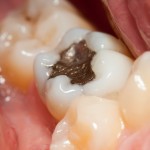
Dental amalgam has been the dental material of choice for many decades. Although, in recent years a greater focus on aesthetics and concerns related to the potential environmental impact of mercury coupled with a more conservative approach to cavity preparation and improvements in aesthetic restorative materials is leading to a decline it its use. In addition at the United Nations Environmental Programme’s Intergovernmental Negotiating Committee (UNEPINC) in 2013 there was an agreement to phase down amalgam use.
When amalgams become defective the traditional approach has been replacement however where the defect is small, repair is an alternative approach. The aim of this review was to evaluate the effects of replacement (with amalgam) versus repair (with amalgam) in the management of defective amalgam dental restorations in permanent molar and premolar teeth.
Searches were conducted in the Cochrane Oral Health Group’s Trials Register, the Cochrane Central Register of Controlled Trials (CENTRAL), Medline, Embase, BIOSIS, Web of Science and the OpenGrey databases. In addition researchers, experts and organisations known to be involved in this field were contacted in order to trace unpublished or ongoing studies. Randomised controlled trials (including split-mouth studies), involving replacement and repair of amalgam restorations in adults with a defective restoration in a molar or premolar tooth/teeth were to be included. Study selection and assessment was conducted independently by two reviewers.
- The search strategy retrieved 201 potentially eligible studies after de-duplication. After examination of the titles and abstracts, full texts of the relevant studies were retrieved but none of these met the inclusion criteria of the review.
The authors concluded
There are no published randomised controlled trials relevant to this review question. There is therefore a need for methodologically sound randomised controlled trials that are reported according to the Consolidated Standards of Reporting Trials (CONSORT) statement. Further research also needs to explore qualitatively the views of patients on repairing versus replacement and investigate themes around pain, distress and anxiety, time and costs.
Comment
As the authors note in their introduction replacement restoration contribute significantly to the costs of dental treatment provided in Europe and the USA. The decision to replace rather than repair may be based on local practice and policy rather than evidence of effectiveness so it is perhaps disappointing that there have been no robust trials conducted on this question to date. The same group have also conducted a review of composite resin repair which we will summarise tomorrow.
Links
Sharif MO, Merry A, Catleugh M, Tickle M, Brunton P, Dunne SM, Aggarwal VR, Chong LY. Replacement versus repair of defective restorations in adults: amalgam. Cochrane Database of Systematic Reviews 2014, Issue 2. Art. No.: CD005970. DOI: 10.1002/14651858.CD005970.pub3.
Sharif MO, Catleugh M, Merry A, Tickle M, Dunne SM, Brunton P, Aggarwal VR, Chong LY. Replacement versus repair of defective restorations in adults: resin composite. Cochrane Database of Systematic Reviews 2014, Issue 2. Art. No.: CD005971. DOI: 10.1002/14651858.CD005971.pub3.

There are studies that give some answers but none are RCT’s. Dental Elf from Oct. 4 2011 has one. JADA Dec. 2015 has a newer study from the United States National Dental Practice Based Research Network -a prospective cohort study . Lead author is Valeria Gordan from my University of Florida.